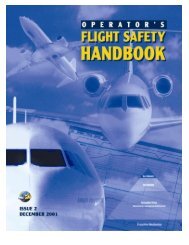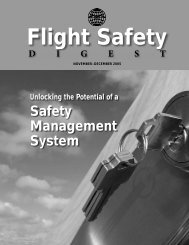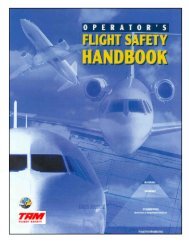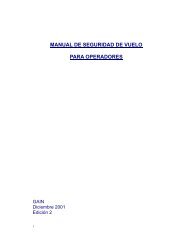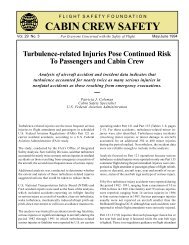Flight Safety Digest October 2005 - Flight Safety Foundation
Flight Safety Digest October 2005 - Flight Safety Foundation
Flight Safety Digest October 2005 - Flight Safety Foundation
You also want an ePaper? Increase the reach of your titles
YUMPU automatically turns print PDFs into web optimized ePapers that Google loves.
12<br />
C ONVERSATION ANALYSIS<br />
Example 12<br />
(0.5)<br />
PIC yeah I dunno how we’re gonna get rid of<br />
tha::t.<br />
(1.5)<br />
PIC I guess: all you can do if it doesn’ go away::,<br />
(1.0) is:: ah:: (1.0) put my information on<br />
your si:::de.<br />
(2.7)<br />
PIC it’s no good the way it i:s:.<br />
(5.8)<br />
PIC ‘n fact it’s a fair way out isn’t it?<br />
(33.8)<br />
PIC >there you go.<<br />
(1.9)<br />
PIC ’s got rid of it for a whi::le anyway.<br />
(1.6)<br />
PIC okay we’re gonna do this: (.) for a bit of a<br />
giggle,<br />
(1.3)<br />
PIC u:::m (.) elevation’s eighteen hundred feet,<br />
(1.5) we got enough fuel to ho:ld for one<br />
point four hours if need be, (1.5) a::nd ah::<br />
we gotta vee ref of one twenty set on the<br />
left,<br />
(0.2)<br />
CP set on the right.<br />
(4.8)<br />
In some of these cases, it is possible that the<br />
copilot could indeed have been responding, but<br />
with a nontalk activity (e.g., a nod or an activity<br />
at an instrument panel). The cockpit is a workplace<br />
where the response to talk is often nontalk<br />
activity; however, such activity almost always is<br />
accompanied by talk (Nevile, 2002, 2004a, 2004b,<br />
<strong>2005</strong>b). A possible exception to this is during a<br />
formal briefi ng, when pilots can speak in longer<br />
(extended) turns, but even in briefi ngs, there usually<br />
is evidence of the pilots acknowledging one<br />
another’s contributions and orienting to a need<br />
to communicate verbally as they work together<br />
(Nevile, 2004b). Other than during briefi ngs, it<br />
is extremely unusual to have a string of turns at<br />
talk where one pilot talks and the other pilot says<br />
nothing in reply.<br />
Conversation analysis discusses silence in terms of<br />
“conditional relevance.” The copilot’s silence can<br />
be seen as an absence of speech in a context where<br />
the PIC’s talk made it relevant for the copilot to<br />
say something. The copilot was entitled to say<br />
something and, indeed, could be expected to say<br />
something. In conversation analysis terms, speech<br />
from the copilot would have been a “projectable”<br />
next action. In these instances, silence is not simply<br />
a case of no one speaking, but a case of the copilot<br />
not speaking. In terms of verbal communicative<br />
exchange between fellow pilots, for whatever reason<br />
one party — the copilot — regularly withheld<br />
talk and opted out.<br />
Correction (Repair)<br />
Conversation analysts have identifi ed a general<br />
conversational practice, repair, which may be<br />
of particular relevance to understanding error in<br />
aviation and how it is managed. Repair refers to<br />
those points in spoken interaction where participants<br />
deal with communicative problems of<br />
some sort. Conversation analysts have found that<br />
in everyday conversation, people typically do not<br />
correct each other. There is a marked tendency for<br />
self-repair (Schegloff, Jefferson and Sacks, 1977);<br />
that is, for the person who produced the “problem<br />
talk/conduct” (the repairable) to repair that talk<br />
or conduct, and to be granted the opportunity to<br />
do so by the other person.<br />
Conversation analysts have shown that participants<br />
distinguish between the initiation of the<br />
repair (i.e., showing that there is a problem) and<br />
actually doing the repair (i.e., fi xing the problem).<br />
So, even where the other might initiate the repair,<br />
there is still the tendency for self-repair. This<br />
preference for self-repair is seen in data for fl ight<br />
crews (Nevile, 2004a). Conversation analysts have<br />
shown that, when another person both initiates<br />
and performs a repair (called other-initiated otherrepair),<br />
that repair is typically delayed, hedged or<br />
qualifi ed in some way. The person doing the repair<br />
softens the blow.<br />
In the CVR data for the accident fl ight, there were<br />
many instances of other-initiated other-repair. The<br />
pilot who produced the problem talk or conduct<br />
did not initiate repair and did not repair that talk<br />
or conduct. Overwhelmingly, the pattern of these<br />
instances involved the PIC both initiating and<br />
performing the correction/repair of the copilot’s<br />
talk or conduct (see Example 13, page 13, and<br />
Example 14, page 13, and also Example 11). The<br />
PIC repaired the copilot’s talk/conduct when there<br />
was no sign of any trouble, in the copilot’s talk/<br />
conduct itself, from the copilot’s point of view. The<br />
fi rst the copilot knew that there was something to<br />
be corrected in his talk or conduct was when the<br />
FLIGHT SAFETY FOUNDATION FLIGHT SAFETY DIGEST OCTOBER <strong>2005</strong>


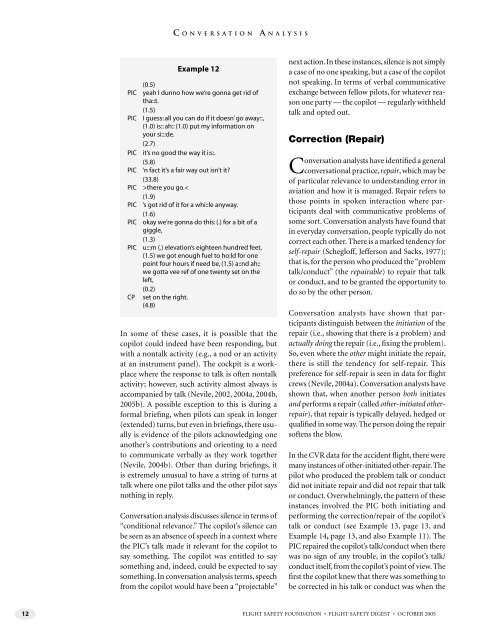

![Download this Issue [PDF 7 MB] - Flight Safety Foundation](https://img.yumpu.com/18859635/1/190x245/download-this-issue-pdf-7-mb-flight-safety-foundation.jpg?quality=85)
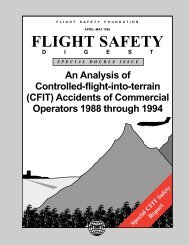
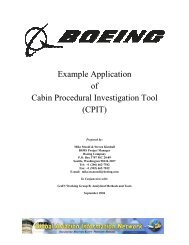
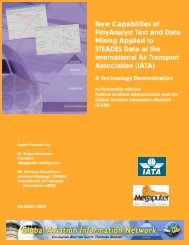
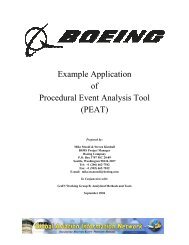
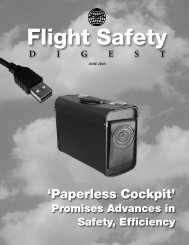
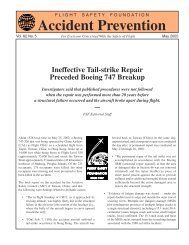
![Download [PDF 8 MB] - Flight Safety Foundation](https://img.yumpu.com/18859366/1/190x245/download-pdf-8-mb-flight-safety-foundation.jpg?quality=85)
